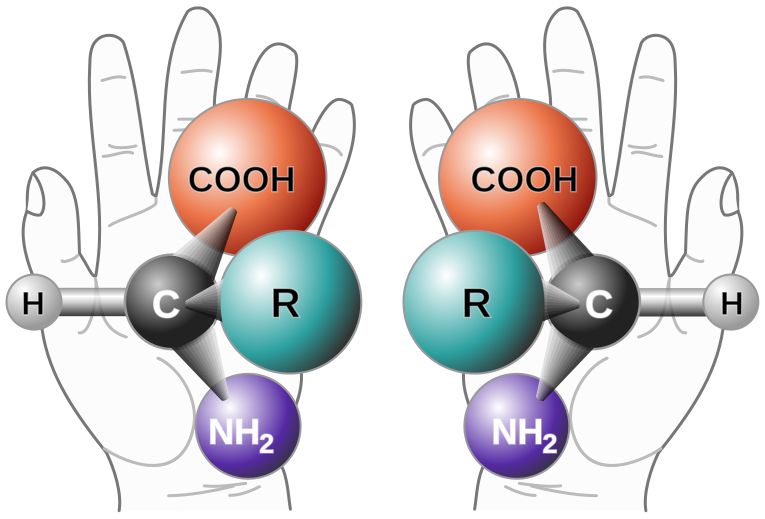The basics: what is an amino acid?
All naturally-occuring proteins are synthesised from the same set of 20 amino acids. Typical amino acids have an amino group (NH2), a carboxyl group (-COOH), a hydrogen atom (signified by 'H') and a side-chain (R) group. All of these are groups that are attached to the central alpha-carbon atom(Cɑ). This carbon is known as an asymmetric carbon atom as it has four different atoms or groups attached to it.
 |
| The general structure of an amino acid. The C=O bond is known as a carbonyl bond. Can you spot where the acidic and basic ends of the molecule could potentially be? |
Enantiomers
They generally defined as stereoisomers that are mirror images of
one another. They are also non-superposable which means that they are not
identical. Take a look at your hands. Go on. They are identical non? Well,
kinda. They are just the same objects but in opposing mirrored orientations of
each other.
If you
didn't know what stereoisomers are, they are simply any two molecules that have
the same molecular formula and constitution (same sequence
of atoms) but are different only in their 3-D arrangement and orientation of
atoms.
If n is the number of asymmetric carbon atoms then the maximum number of stereoisomers is: 2n
Okay, so how does this link with
amino acids? Well, amino acids with four different groups arranged around the
central ɑ-carbon atom are actually able to
be in two different orientations. This means that they can attain both the D or
L configurations.
 |
| Very handy, ain't it? :P |
The 20 standard amino acids
Glycine (Gly, G) has a hydrogen atom as its R group. It is thus the smallest possible amino acid. The atoms that compose the R will undoubtedly affect the chemical and physical properties of the molecule (amino acid) as a whole. Alanine, valine, leucine, isoleucine and methionine have side-chains of differing structures that are hydrophobic and chemically inert, for example.
Phenylalanine, tyrosine and tryptophan are also hydrophobic. The basic amino acids arginine and lysine have positively charged side-chains.

Cysteine and methionine are the only two of the naturally-occuring amino acids that contain the element sulphur. Most amino acids only contain CHON (carbon, hydrogen, oxygen and nitrogen).
As you can see, the R groups of amino acids are very important.
Out of what is known as the 20 standard amino acids, 19 are ɑ-amino acids with a primary amino group and a carboxylic acid group attached to a central carbon atom. The one exception to this general arrangement is proline which is a secondary amino acid and has a secondary amino group. It is actually an ɑ-imino acid.
Amino acids and pH
Firstly, pH is the unit we use to measure the concentration of hydrogen ions in a solution. Acids are acidic because they are proton (hydrogen ion) donors. Bases are basic because they accept protons. Amino acids can do both because of two of the groups on the central carbon: the primary amino group and the carboxyl group. Amino acids are buffers.
Well, that's it then! See you next week where I shall be continuing with biomolecules. Don't forget to send me your feedback at praveenprathapan28@gmail.com.
Exocytosis
Glycine (Gly, G) has a hydrogen atom as its R group. It is thus the smallest possible amino acid. The atoms that compose the R will undoubtedly affect the chemical and physical properties of the molecule (amino acid) as a whole. Alanine, valine, leucine, isoleucine and methionine have side-chains of differing structures that are hydrophobic and chemically inert, for example.
Phenylalanine, tyrosine and tryptophan are also hydrophobic. The basic amino acids arginine and lysine have positively charged side-chains.

Cysteine and methionine are the only two of the naturally-occuring amino acids that contain the element sulphur. Most amino acids only contain CHON (carbon, hydrogen, oxygen and nitrogen).
As you can see, the R groups of amino acids are very important.
Out of what is known as the 20 standard amino acids, 19 are ɑ-amino acids with a primary amino group and a carboxylic acid group attached to a central carbon atom. The one exception to this general arrangement is proline which is a secondary amino acid and has a secondary amino group. It is actually an ɑ-imino acid.
Amino acids and pH
Firstly, pH is the unit we use to measure the concentration of hydrogen ions in a solution. Acids are acidic because they are proton (hydrogen ion) donors. Bases are basic because they accept protons. Amino acids can do both because of two of the groups on the central carbon: the primary amino group and the carboxyl group. Amino acids are buffers.
Well, that's it then! See you next week where I shall be continuing with biomolecules. Don't forget to send me your feedback at praveenprathapan28@gmail.com.
Exocytosis
No comments:
Post a Comment